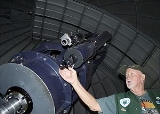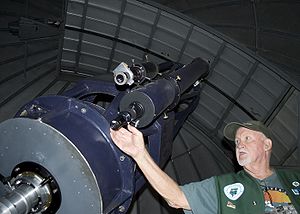
Goldendale Observatory State Park
Encyclopedia

Goldendale, Washington
Goldendale is a rural agricultural town in and the county seat of Klickitat County, Washington, United States, near the Columbia River Gorge. The population within city limits was 3,760 at the 2000 census and 3,407, a 9.4% decrease at the 2010 census. A nationally known point of interest is north...
. It was acquired by the state of Washington in 1980, after being operated by the Goldendale Observatory Corporation since October 13, 1973.
The park consists of five acres (20,000 m²) of ground located on top of a 2,100 ft (640 m) hill. Access is via a winding road through an oak forest. The site includes a small picnic area, an interpretive center, amphitheater, and the observatory. It has several telescopes, including the main instrument. It receives about 30-40,000 visitors per year.
The telescope was the work of four amateur astronomers; M.W. McConnell, John Marshall, Don Conner and O.W. VanderVelden who built a 24.5 inch (622 mm) Cassegrain
Cassegrain reflector
The Cassegrain reflector is a combination of a primary concave mirror and a secondary convex mirror, often used in optical telescopes and radio antennas....
reflecting telescope
Reflecting telescope
A reflecting telescope is an optical telescope which uses a single or combination of curved mirrors that reflect light and form an image. The reflecting telescope was invented in the 17th century as an alternative to the refracting telescope which, at that time, was a design that suffered from...
. This instrument was originally intended for Clark College
Clark College (Washington)
Clark College is a community college located in Vancouver, Washington.The college, which celebrated its 75th anniversary on October 1, 2008, was founded as a private, two-year, junior college in 1933...
in Vancouver, Washington
Vancouver, Washington
Vancouver is a city on the north bank of the Columbia River in the U.S. state of Washington. Incorporated in 1857, it is the fourth largest city in the state with a 2010 census population of 161,791 as of April 1, 2010...
. However, due to the typically cloudy weather on the windward side of the Cascade Mountain Range, it was eventually donated to the town of Goldendale, far enough leeward to be comparatively cloud-free. An observatory was constructed on this hilltop to the north of the town, and became a public education center. The observatory dome has a diameter of 20 ft (6.1 m).
On February 26, 1979, the observatory served as the National Astronomical League official headquarters during a solar eclipse
Solar eclipse
As seen from the Earth, a solar eclipse occurs when the Moon passes between the Sun and the Earth, and the Moon fully or partially blocks the Sun as viewed from a location on Earth. This can happen only during a new moon, when the Sun and the Moon are in conjunction as seen from Earth. At least...
which occurred on February 26, 1979, six years after the observatory opened. Approximately 15,000 people came to the town of Goldendale on that date to observe the eclipse.
The observatory has been threatened with closure due to state budget cuts several times beginning in 1980, but has thus far managed to remain in operation.
In 2010, the Observatory's 2-hectares was designated by the International Dark Sky Association as a Dark Sky Park.

